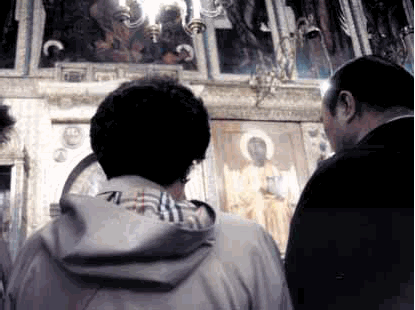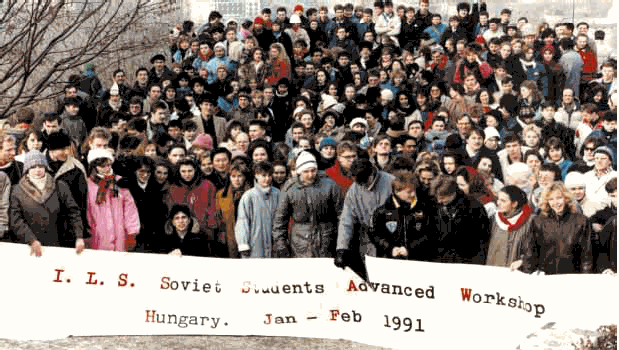
40 Years in America

|
|
40 Years in America |
|
Educating Soviet Leaders and Youth

Rev. and Mrs. Moon praying at St. Basilís Cathedral
The opportunities for the movement to sponsor seminars for Soviet officials and eventually conduct straight Divine Principle workshops for thousands of Soviet students and teachers were even more striking. The USSR was exploring ways to preserve some form of unity among its fifteen republics, which were rapidly splintering, and in response to Rev. Moonís invitation, decided to allow its leadership to attend American Leadership Seminars in the U.S. Dr. Ward, who lectured, reported that "In December of 1990 and February of 1991, the ALC sponsored seminars for 80 deputies of the Supreme Soviet (federal, republic and city levels) as well as some 60 cabinet ministers and members of parliament from Bulgaria, Czechoslovakia, Germany, Hungary, Poland, Romania, and Yugoslavia." He noted that participants "received lectures on VOC theory as well as briefings on the underpinnings of American democracy." Then, between April 30 - May 7, 1991, the World Leadership Conference, affiliated with ALC, "sponsored an unprecedented seminar and fact-finding tour in Washington, D.C. for approximately 200 high-ranking Soviet officials and political leaders...from all 15 republics of the U.S.S.R. Ward stated, "This was "the only time during the final years of the Soviet Union that any person, government, or private organization brought together representatives from all 15 Soviet republics."
The demise of Marxism as a viable ideology created a void as serious as the splintering of the Soviet republics, and officials in various education ministries gave the movement a free rein to educate Soviet students. Rev. Moon assigned this responsibility to CARP. Initially, he asked Dr. Joon-ho Seuk, National Director of USA CARP, to bring 200 Soviet students to the United States for education in the Divine Principle. Accustomed to the time and effort it took "to get 200 American students to come and hear the Principle," Dr. Seuk and his associates were shocked to be ushered directly into the offices of university rectors and to have their pick from among "the elite of the elite" students in Soviet universities. The procedure was that the deans and faculties pre-selected the very best students in academics, leadership ability, and proficiency in English from among the many who applied to participate in the seminar. Afterwards, CARP representatives interviewed them, selecting one out of every four candidates. In addition, all students were informed of CARPís strict moral code for the conference: no smoking, drinking or romantic relationships. Between July 1-August 19, 1990, four separate groups of about 100 Soviet students each, 380 students in all, participated in the International Leadership Seminars (ILS) which were convened at Unification Theological Seminary. CARP representatives explained to the rectors of the universities that students and accompanying professors "would listen to Rev. Moonís vision for world peace during five days of intensive study -- with exams!" Basically, students studied the Divine Principle. There was a day of sightseeing in New York City before the conference began and a trip to Philadelphia and Washington, D.C. afterwards, interspersed with fellowship, panel discussions and banquets.
The success of the initial ILS seminars led to large-scale education within the CIS. This was mainly led by American members. Many members jumped at the opportunity to teach those willing to listen. Between January and February of 1991, an "advanced" seminar was held for 700 Soviet students at three sites in Hungary. Then, during July and August 1991, CARP held 24 workshops for 2,000 students at four sites in the Baltics. These included 5, 10, and 21-day programs that were staffed by 150 volunteers from the American movement. Rev. Moon had announced a worldwide pioneering condition for American members whereby they were to witness in foreign countries for forty days at a time for the next several years. Apart from this, many American members had longed to take part in the Moscow rally. Staffing the ILS seminars was a chance for many of them to participate in the extension of that rally. Their participation became uncomfortably but invigoratingly direct during the late summer as the summer workshops intersected with great events of state. As described in one account, "The transformations that occurred in the hearts and minds of the students was matched only by the dramatic rebirth of the Soviet Union itself, following a dangerous military coup that failed."

Soviet Students at the Hungarian workshop, Feb. 1991
The birth of the Commonwealth of Independent States (C.I.S.) did not interfere with the workshop program, at least not in 1992 when USA CARP, with broad-based member and movement support, sponsored the largest workshops in the churchís history. Between January 26 and February 9, 1992, CARP held 27 workshops at 18 different workshop sites in the Crimea south of the Ukraine for 3,160 students. In the course of the program, CARP hired over 200 buses and 100 cars. Also, since all of the lectures were given using CARPís custom-made Divine Principle slide presentation, forty thousand slides had to be made. Sites were difficult to obtain due to the changing political and economic situation, and in one case students were on their way before camps were secured. During the spring, between March 20 and April 10, the first Divine Principle workshop for high school teachers and students of the C.I.S. shattered the previous workshop record with 7,229 participants: 942 high school teachers and principals, 5,834 high school students, 293 university students, 124 parents, 21 professors and 20 others. They filled 40 workshops at 23 workshop sites and a total of 540 buses and 200 cars were used to transport participants.
The program was initiated by Rev. Moon and sponsored by the public ministries of education of Russia, the Ukraine, and other participating republics. According to one report, 17,000 students applied from Moscow alone. Several hundred university students who attended earlier programs received permission to support the high school studentsí workshop as staff, and "In Moscow, during the Sunday service following the workshop, the auditorium used was filled beyond its capacity with more than one thousand in attendance."
Izvestia, one of the largest newspapers in the C.I.S., published an adaptation of Divine Principle entitled God and Us in April 1992, and that summer "the largest series of Principle workshops yet in Unification Church history" educated 18,042 guests at 129 workshops held at 26 workshop sites over a period of 8 weeks in 5 different regions of the country. One site was in Central Asia, five were in the Moscow region, one was outside St. Petersburg, eight were in Latvia and eleven were in Lithuania. Two hundred and forty American members served as staff although many sites had only five or six staff members taking care of up to two hundred people. The movement rented 1,100 buses and 760 cars, as well as three trains to transport the overflow at one peak point during the summer. Over 8,000 teachers were educated in beginner and advanced workshops and since 60 percent of them were non-English speaking, all lectures were translated by young student members. CARP considered its education of teachers to "be the foundation upon which a Principle-based curriculum could be introduced in the high schools."
Most understood that the opportunity to conduct massive workshops in the newly created C.I.S. resulted from a unique set of circumstances. The key element was the breakthrough Rev. Moon achieved through the Moscow rally. However, a host of additional factors aided the movementís efforts. Prices were cheap and the monetary exchange rate was incredibly favorable so that CARP could rent multiple sites and means of transportation at a fraction of the cost elsewhere. Soviet students, as well, were fascinated with all things Western that due to the heavy participation of American members in the workshops was how the movement was perceived. Third, there was little competition in the period immediately preceding and following the fall of the Soviet Union.
The movement had the capability for far more rapid organizational mobilization than more ponderous Christian bodies, and the Russian Orthodox Church had not yet reconstituted itself. Discerning Unificationists knew that these circumstances would not hold indefinitely and that they operated within a limited window of opportunity. Negativity about Rev. Moon would filter in, prices would rise, American staff members would return home, and formidable competitors would emerge. For this reason, while efforts at mass evangelism continued beyond this period, increasing emphasis was placed on developing an indigenous movement and a curriculum of moral education, which would institutionalize the Moscow rally and its aftermath on a permanent basis.
Download entire page and pages related to it in ZIP format
Table of Contents
Information
Tparents Home